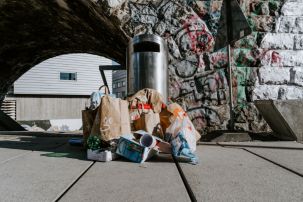Lesson summary
Students will create a short film in which they consider concepts of personal responsibility and active citizenship as they relate to the litterbug. They will investigate the environmental and social impacts of littering.
Learning intentions:
Students will...
- understand the social and environmental implications of littering
- begin to take responsibility for unwanted food packaging
- rethink the concept of why people litter.
Success criteria:
Students can...
- think critically about how other people might think about and perceive litter
- be persuasive when communicating messages about not littering.
Lesson guides and printables
Lesson details
Curriculum mapping
Australian Curriculum content descriptions:
Year 7 English:
- Use interaction skills when discussing and presenting ideas and information, selecting body language, voice qualities and other elements, (for example music and sound) to add interest and meaning (ACELY1804)
- Plan, rehearse and deliver presentations, selecting and sequencing appropriate content and multimodal elements to promote a point of view or enable a new way of seeing (ACELY1720)
- Plan, draft and publish imaginative, informative and persuasive texts, selecting aspects of subject matter and particular language, visual, and audio features to convey information and ideas (ACELY1725)
Year 8 English:
- Plan, rehearse and deliver presentations, selecting and sequencing appropriate content, including multimodal elements, to reflect a diversity of viewpoints (ACELY1731)
- Create imaginative, informative and persuasive texts that raise issues, report events and advance opinions, using deliberate language and textual choices, and including digital elements as appropriate (ACELY1736)
Syllabus outcomes: EN4-3B.
General capabilities: Critical and creative thinking Literacy.
Cross-curriculum priority: Sustainability OI.3, OI.8.
Resources required
- Device with movie editing software
- Recording device
- Various props as required, computer with movie editing software.
Skills
This lesson is designed to build students’ competencies in the following skills:
- Communication
- Critical thinking
- Community engagement
- Problem solving
Additional info
Following this lesson plan is an ideal way for your school to take part in Schools Clean Up Day or a Clean Up on any day of the year. You’ll be joining thousands of amazing teachers in making a difference and creating positive environmental change.


Welcome back!
Don't have an account yet?
Log in with:
By signing up to Cool.org you consent and agree to Cool's privacy policy to
store, manage and process your personal information. To read more, please see
our privacy policy here(Opens in new tab).
Create your free Cool.org account.
Many of our resources are free, with an option to upgrade to Cool+ for premium content.
Already have an account?
Sign up with:
By signing up to Cool.org you consent and agree to Cool's privacy policy to
store, manage and process your personal information. To read more, please see
our privacy policy here(Opens in new tab).